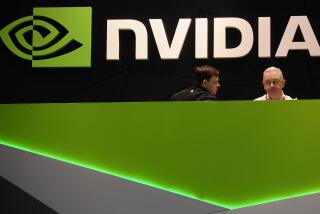THE TIMES 100 : The Best Performing Companies in California : THE VIEW FROM THE STREET : High Flyer’s Formula: Be 1st to Market : Computers: Cisco Systems of Menlo Park introduced a device to speed networks. Last year the company’s value tripled to $2.4 billion.
- Share via
Silicon Valley has plenty of tales of start-up companies leaping from garage to corporate giant seemingly overnight.
But for Don Valentine, who has helped finance 250 fledgling high-tech firms in the past two decades, nothing quite compares to the $2.5 million his Menlo Park-based Sequoia Capital venture firm put into Cisco Systems Inc., a data communications products maker.
“It’s unprecedented,” said Valentine, who serves as chairman of Cisco Systems, also in Menlo Park. “Nothing has been like this.”
Cisco impresses even the most jaded of analysts. The company’s market value has leaped from $786 million a year ago to $2.4 billion this year, enough to move it from 76th to 28th on this year’s Times 100 market-value list.
Cisco’s success lies in a single product, called a router, that the company had the good fortune of developing and marketing before any other research and development firm. Its history goes back to the late 1970s, when several individuals associated with Stanford University found that many companies, government agencies and universities had amassed a variety of different computer networks, each with its own electronic language.
Stanford graduate students Leonard Bosack and Sandra Lerner, along with several colleagues, used federal government research grants and their own money to develop a box that speaks many different computer languages, unlike other products then on the market. The device enables data to be routed at high speeds from network to network, regardless of different electronic dialects.
When the company was founded in 1984, the routers were installed mainly for university computing networks and government agencies, with the management team operating out of the living room of Bosack and Lerner’s Atherton home. (Bosack and Lerner have since left to start another high-tech company, XKL Systems Corp. in Redmond, Wash.)
But Cisco’s customer list grew, as major companies moved to networks of personal computer work-stations and looked for a way out of the frustration of linking different networks of IBM and Macintosh computers.
“You’re not going to go to some Esperanto thing, where it’s all one language,” Jeff Paine, Cisco’s marketing manager, said of the modern babble of computer tongues. “It’s a heterogeneous world and there’s no turning back.”
Cisco’s list of 35,000 customers is made up mainly of businesses, including Boeing, American Telephone & Telegraph, Motorola and IBM. The company delivers an average 2,500 routers a month, at a cost of $5,000 to $50,000 each. Cisco has expanded to 750 employees and now operates out of five buildings in the Bay Area. (The company is named for the last two syllables in San Francisco).
Meanwhile, sales have surged to $183.1 million for the year ended July 28, compared to $69.8 million the year before. Analysts forecast that revenue will reach $300 million this fiscal year. While other high-tech firms turn over their inventory four times a year on average, Cisco Systems does it 16 times.
Luck, company officials admit, has a lot to do with its success.
“Whenever a business catches the timing of a wave right, they are untouchable,” Valentine said. “We just caught the wave.”
He added: “Without the Cisco product, these companies had a problem like the Tower of Babel. With the Cisco router, they can make sense of these complicated networks.”
The company has been praised for its efficiency. Many of the component parts are contracted out to suppliers and partners; Cisco designs and connects the final product. Profits have more than tripled from $13.9 million, or 50 cents a share, in fiscal 1990, to $43.2 million, or $1.38 per share, in fiscal 1991. Analysts predict that earnings will amount to $1.52 by July.
“We are not in the business of bending metal, painting things and packing components on boards,” Paine said. “What we do is pick our partner vendors very carefully.”
The product also is dependent on software, rather than silicon chips, which makes it more flexible toward customer needs, Paine said.
The company’s stock has soared. Since Cisco went public in February, 1990, there have been a couple of 2-for-1 splits. Even then, shares rose from $11.13 two years ago to $36.38 last week.
More to Read
Inside the business of entertainment
The Wide Shot brings you news, analysis and insights on everything from streaming wars to production — and what it all means for the future.
You may occasionally receive promotional content from the Los Angeles Times.










